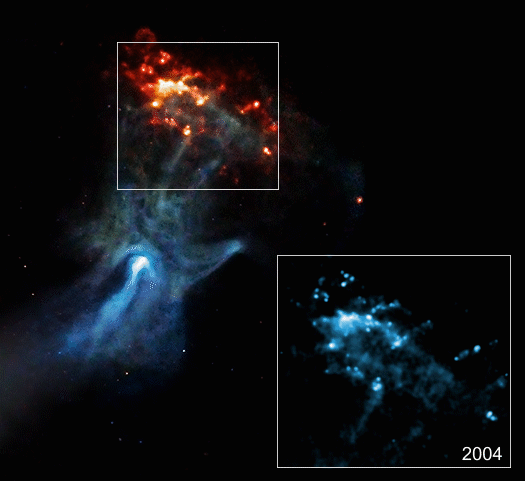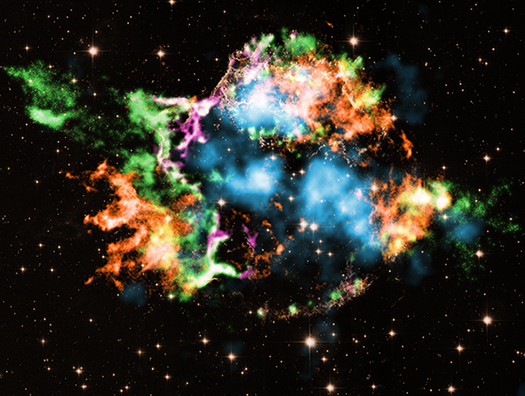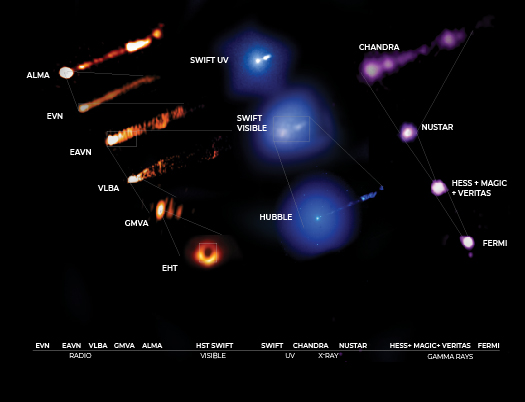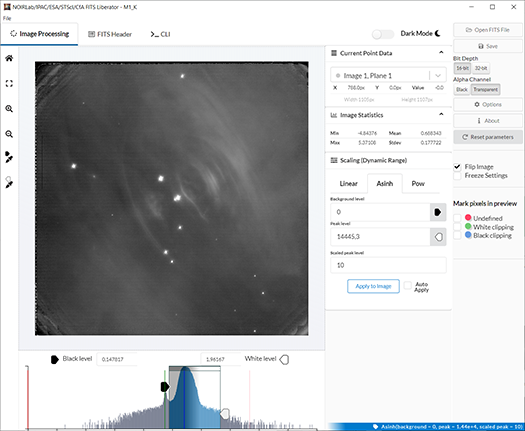Cosmic Hand Hitting a Wall
Motions of a remarkable cosmic structure have been measured for the first time, using NASA's Chandra X-ray Observatory. The blast wave and debris from an exploded star are seen moving away from the explosion site and colliding with a wall of surrounding gas.
Astronomers estimate that light from the supernova explosion reached Earth about 1,700 years ago, or when the Mayan empire was flourishing and the Jin dynasty ruled China. However, by cosmic standards the supernova remnant formed by the explosion, called MSH 15-52, is one of the youngest in the Milky Way galaxy. The explosion also created an ultra-dense, magnetized star called a pulsar, which then blew a bubble of energetic particles, an X-ray-emitting nebula.
X-ray Screams From Toddler Suns

Konstantin Getman
We are very happy to welcome Dr. Konstantin Getman as our guest blogger, who is also the first author of the studies featured in our latest press release. He received an honor master's degree in astronomy at Moscow State University in 1994 and his Ph.D. degree in physics and mathematics at Pushkov Institute of Terrestrial Magnetism, Ionosphere and Radiowave Propagation of the Russian Academy of Sciences (IZMIRAN) in 1999. Since 2001, he has been at the Pennsylvania State University where he is currently a research professor. His research is focused on star formation and stellar activity, about which he authored and co-authored 80 peer-reviewed publications.
The Sun is covered with magnetic field lines like an animal is covered with fur. These twisted and sheared lines store a lot of “free” energy. When solar magnetic lines of opposite polarity come close to each other, they interact, change their topology, and release free energy, causing powerful and eruptive events, that scientists call “flares”. These flare processes include acceleration of charged particles in the Sun’s upper atmosphere (called the corona), emission of large amounts of radiation in various energy bands (such as radio, microwave, optical, and X-ray), and launching of streams of plasma and magnetic field into space (called coronal mass ejections, or CMEs).
Magnetized Threads Weave Spectacular Galactic Tapestry
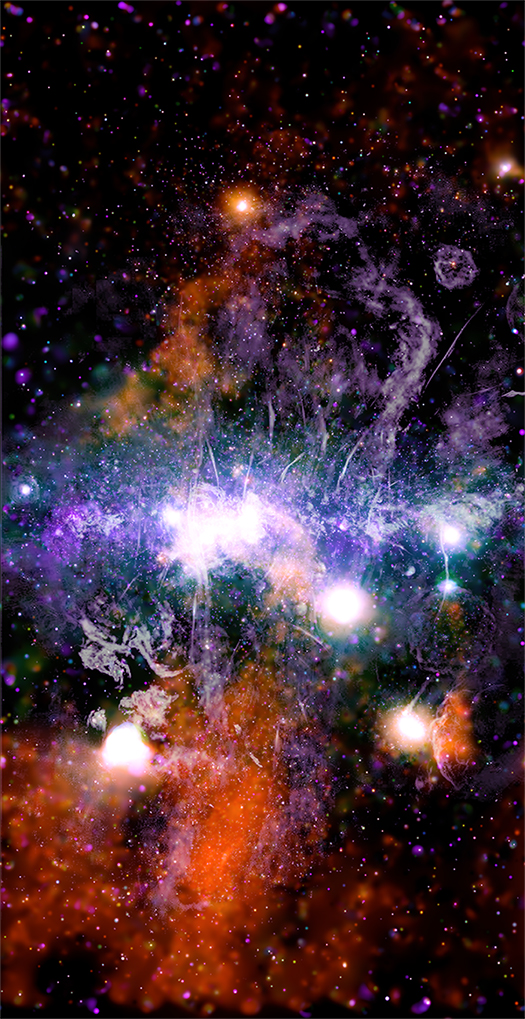
The Galactic Center of the Milky Way
Credit: X-ray: NASA/CXC/UMass/Q.D. Wang; Radio: NRF/SARAO/MeerKAT
Threads of superheated gas and magnetic fields are weaving a tapestry of energy at the center of the Milky Way galaxy. A new image of this new cosmic masterpiece was made using a giant mosaic of data from NASA's Chandra X-ray Observatory and the MeerKAT radio telescope in South Africa.
The new panorama of the Galactic Center builds on previous surveys from Chandra and other telescopes. This latest version expands Chandra's high-energy view farther above and below the plane of the Galaxy — that is, the disk where most of the Galaxy's stars reside — than previous imaging campaigns. In the image featured in our main graphic, X-rays from Chandra are orange, green, blue and purple, showing different X-ray energies, and the radio data from MeerKAT are shown in lilac and gray. The main features in the image are shown in a labeled version.
Chandra Discoveries in 3D Available on New Platform
Your browser does not support the video tag.
![]() More Information
More Information
Credit: VR version: VR model: NASA/CXC/Brown Univ./A.Dupuis et al.;
Simulation: INAF/S. Ustamujic et al.; X-ray data: NASA/CXC/MSFC/D.Swartz et al.
A collection of the 3D objects from NASA's Chandra X-ray Observatory is now available on a new platform from the Smithsonian Institution. This will allow greater access to these unique 3D models and prints for institutions like libraries and museums as well as the scientific community and individuals in the public.
The Chandra X-ray Observatory is one of NASA's Great Observatories (along with the Hubble Space Telescope, Spitzer Space Telescope, and Compton Gamma-ray Observatory). Chandra, the world's most powerful X-ray telescope, is operated by the Smithsonian Astrophysical Observatory in Massachusetts.
Chandra's 3D datasets are now included in Voyager, a platform developed by the Smithsonian's Digitization Program Office, which enables datasets to be used as tools for learning and discovery. Viewers can explore these fascinating 3D representations of objects in space alongside a statue of George Washington or a skeleton of an extinct mammoth.
Bubbles With Titanium Trigger Titanic Explosions
Astronomers using NASA's Chandra X-ray Observatory have announced the discovery of an important type of titanium, along with other elements, blasting out from the center of the supernova remnant Cassiopeia A (Cas A). This new result, as outlined in our latest press release, could be a major step for understanding exactly how some of the most massive stars explode.
The different colors in this new image mostly represent elements detected by Chandra in Cas A: iron (orange), oxygen (purple), and the amount of silicon compared to magnesium (green). Titanium (light blue) detected previously by NASA's NuSTAR telescope at higher X-ray energies is also shown. These Chandra and NuSTAR X-ray data have been overlaid on an optical-light image from the Hubble Space Telescope (yellow).
Telescopes Unite in Unprecedented Observations of Famous Black Hole
Your browser does not support the video tag.
![]() More Information
More Information
Video compilation: NASA/GSFC/SVS/M.Subbarao & NASA/CXC/SAO/A.Jubett
In April 2019, scientists released the first image of a black hole in the galaxy M87 using the Event Horizon Telescope (EHT). This supermassive black hole weighs 6.5 billion times the mass of the sun and is located at the center of M87, about 55 million light-years from Earth.
The supermassive black hole is powering jets of particles that travel at almost the speed of light, as described in our latest press release. These jets produce light spanning the entire electromagnetic spectrum, from radio waves to visible light to gamma rays.
To gain crucial insight into the black hole's properties and help interpret the EHT image, scientists coordinated observations with 19 of the world's most powerful telescopes on the ground and in space, collecting light from across the spectrum. This is the largest simultaneous observing campaign ever undertaken on a supermassive black hole with jets.
The NASA telescopes involved in this observing campaign included the Chandra X-ray Observatory, Hubble Space Telescope, Neil Gehrels Swift Observatory, the Nuclear Spectroscopic Telescope Array (NuSTAR), and the Fermi Gamma-ray Space Telescope.
What We Found When We X-rayed Uranus

Affelia Wibisono
We are pleased to welcome Affelia Wibisono, who received her Masters degree in Physics from Royal Holloway, University of London in 2012, as our guest blogger. She worked as a science communicator at London’s Science Museum and the Royal Observatory Greenwich before starting her PhD in 2018 at University College London’s Mullard Space Science Laboratory (MSSL). Her research interests are in X-ray emissions from planets in our Solar System, in particular how and why Jupiter produces intense X-ray auroras.
Huge, violent and exotic objects in space such as black holes, supernovae and quasars are what usually come to mind when one thinks about X-ray astronomy. But it’s the more humble X-ray sources found closer to home that my research group and I want to know more about. Many things in our Solar System emit X-rays, such as the Sun, comets, moons and even Pluto. Astronomers have also detected X-rays from the four rocky planets, Mercury, Venus, Earth and Mars, and from the gas giants Jupiter, and Saturn. However, efforts to find X-rays from Uranus in 2002 and 2017 were fruitless — or so we thought.
Data Sonification: Stellar, Galactic, and Black Hole
Your browser does not support the video tag.
This latest installment from our data sonification series features three diverse cosmic scenes. In each, astronomical data collected by NASA's Chandra X-ray Observatory and other telescopes are converted into sounds. Data sonification maps the data from these space-based telescopes into a form that users can hear instead of only see, embodying the data in a new form without changing the original content.
Upgrading Our Views of the Universe
How do we image our Universe? There are many different ways of translating information from the cosmos. But in working with scientific data and image processing software, you can create your own astronomy images from FITS files. "FITS," which stands for Flexible Image Transport System, is a digital file format used mainly by astronomers to work with data of cosmic objects. Today, we are happy to help announce an update to the open source FITS Liberator software that can be used to process your own astronomical data. —Kimberly Kowal Arcand (CfA)
Astronomy is predominantly a visual science. However, an important tool is needed to produce breathtaking color images from the observations made with telescopes such as the NASA/ESA Hubble Space Telescope, NASA's Chandra X-ray Observatory, or the telescopes of NSF's NOIRLab at the international Gemini Observatory, Kitt Peak National Observatory, and Cerro Tololo Inter-American Observatory. The key to unlocking those magnificent vistas is specialized image-processing software.
Cosmic Poetry Competition 2021: The Winners
We are delighted to again welcome Jonathan Taylor as a guest blogger. Jonathan is the author of several novels and poetry collections, the editor of several anthologies, and Associate Professor in Creative Writing at the University of Leicester in the UK.
I've always been fascinated by the intersections and overlaps between Creative Writing and science. It's always seemed to me that poetry and cosmology, for example, share a great many characteristics, in their methods and means of communication: they both play with, even bend, language; they both use metaphor and analogy; they both re-enchant and defamiliarize our universe, so we see it anew. Having written various poems over the years for Chandra X-Ray Observatory (in March 2010, June 2010, April 2012, and August 2016), I often find the poetry is already there, waiting to be discovered, in the language used to capture Chandra's amazing revelations.
Hence, as part of their course, we encourage our Creative Writing students at Leicester University to explore some of the fascinating overlaps between their writing and scientific research – including the work of NASA and Chandra X-Ray Observatory. Over the years, this has resulted in various student competitions (in December 2010: part one and part two; May and June 2012: part one and part two; February 2016, and February 2017). In January 2021, we held a new competition for student writers, in which they were again invited to submit poems that explore – directly or indirectly, literally or metaphorically – the language and findings from one of Chandra's press releases. You can read the two beautiful winning entries below: 'IC 4593' by Laura Sygrove, and 'A New Cosmic Triad of Sound' by Rebecca Hughes.

